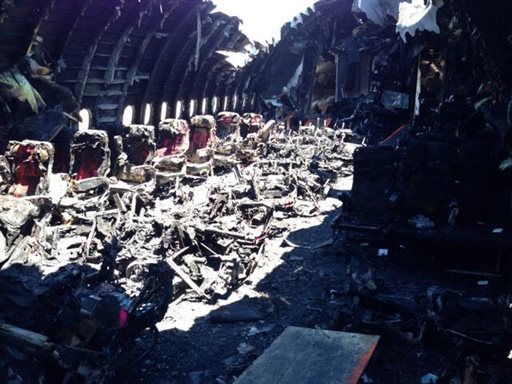
This image released by the National Transportation Safety Board, on Thursday, July 11, 2013, shows the charred remains of Asiana Airlines Flight 214 in San Francisco. The Asiana flight crashed upon landing Saturday, July 6, at San Francisco International Airport, and two of the 307 passengers aboard were killed. (AP Photo/NTSB)
SAN FRANCISCO — The focus of the probe into Asiana Flight 214 switched squarely to the pilots after investigators found no evidence of mechanical problems, the head of the U.S. National Transportation Safety Board said.
In her final briefing before the agency concluded its on-site detective work, NTSB Chairman Deborah Hersman said Thursday the airplane showed no signs of a breakdown, and on voice recorders, the pilots of the Boeing 777 fail to notice that their approach is dangerously low and slow until it’s too late.
“There is no mention of speed until about nine seconds before impact, when they’re at 100 feet (30 meters),” she said Thursday. Just seconds before impact, two of the pilots call for the landing to be aborted.
Investigators have stressed that nothing has been definitively ruled out and no firm conclusions reached. The agency’s final evaluation is expected to take more than a year.
The jet itself, though heavily damaged, had no malfunctions in any critical systems, including the engines and flight-control surfaces, the autopilot, the autothrottles and the flight director, Hersman said.
Two Chinese teens were killed and 180 of the 307 people on board were hurt Saturday when the airliner slammed into a seawall at the end of the runway. The impact ripped off the back of the plane, tossed out three flight attendants and scattered pieces of the jet across the runway as it spun and skidded to a stop.
The battered passengers, some with broken bones, were told over the jet’s public address system to stay in their seats for another 90 seconds while the cockpit consulted with the control tower, a safety procedure to prevent people from evacuating into life-threatening fires or machinery.
Authorities are investigating whether one of the two teens who died may have been run over by a fire truck rushing to the burning jet.
The Federal Aviation Administration has found “no significant issues” during 134 unannounced mechanical, pilot or avionic checks on Aviana airliners over the last 18 months, Hersman said.
She has said that pilots Lee Gang-kuk, who was landing the jet for his first time at the San Francisco airport, and Lee Jeong-Min, who was training him, were ultimately responsible for a safe landing.
While the pilots were manually flying the jet for the landing, as expected on a clear, sunny day, they told investigators they thought the airliner’s speed was being controlled by an autothrottle set for 157 mph (252 kph).
Inspectors found that the autothrottle had been “armed,” or made ready for activation, Hersman said. But investigators are still determining whether it had been engaged. In the last two minutes, there was a lot of use of autopilot and autothrottle, and investigators are going to look into whether pilots made the appropriate commands and if they knew what they were doing, she said.
Experts said the evidence points toward pilot error.
Lee Collins, a pilot with 29 years of experience on a variety of airliners, said the question is how the Asiana pilots could make such a “gross error.”
“What caused this airplane to crash was their failure to maintain proper airspeed,” Collins said.
During the evacuation, many passengers jumped out the back of the plane or slid down inflated slides through emergency exits. Then, said some, an unnerving wait began. Emergency phone tapes recorded frantic callers, pleading for help.
“We’ve been on the ground, I don’t know, 20 minutes, a half hour,” said one woman. “There are people laying on the tarmac with critical injuries, head injuries. We’re almost losing a woman here. We’re trying to keep her alive.”
San Francisco Fire Department spokeswoman Mindy Talmadge said some passengers may not have immediately seen ambulances at the scene because they were dispatched to a nearby staging area, as first responders assessed who needed to be taken to the hospital.
“You don’t cause more chaos in an already chaotic situation,” Talmadge said. “You don’t do that with 50 ambulances running around all over the place.”
Within 18 minutes of receiving word of the crash, five ambulances and more than a dozen other rescue vehicles were at the scene or en route, and airport fire crews and crews from other agencies were already on the scene, Talmadge said.
“Our response was immediate,” Talmadge said. “It’s not what you may see in the movies. That’s not how a real-life response is to a large-scale incident.”